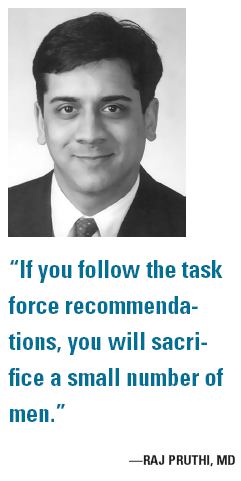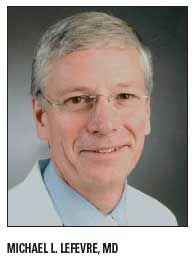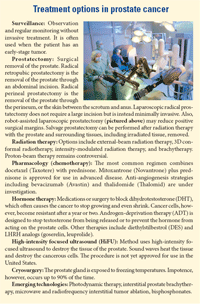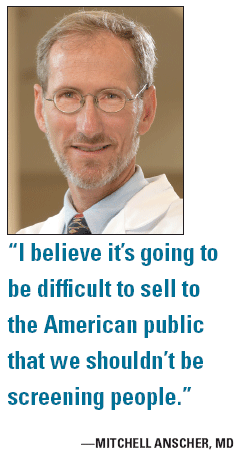New task force guideline returns PSA screening to center stage
When the U.S. Preventive Services Task Force reported that routine prostate cancer screening for older men appears to result in little benefit, the announcement raised more than a few eyebrows in the urologic medical community.
ABSTRACT: This year marks the 26th anniversary of PSA testing, but has the screening tool’s time come and gone? Experts weigh in on the pros and cons of the PSA test.

When the U.S. Preventive Services Task Force reported that routine prostate cancer screening for older men appears to result in little benefit, the announcement raised more than a few eyebrows in the urologic medical community.
The independent panel of private sector experts said that testing men age 75 and older for the prostate-specific antigen (PSA) can cause so much harm later on, including tests and treatment resulting in erectile dysfunction, urinary incontinence, bowel dysfunction, and even death, that the risks outweigh the benefits, which it said include only a small likelihood of living any longer. The group also found inadequate evidence to determine whether treatment for prostate cancer detected using the test improves the outcomes of men younger than 75.
“These harms are especially important because some men treated for prostate cancer would never have developed symptoms related to cancer during their lifetime,” the USPSTF wrote. “Because a 75-year-old man has an average life expectancy of about 10 years, very few men age 75 years or older would experience a mortality benefit.”
The organization urged that clinicians not order PSA testing without discussing with patients the possible benefi ts and known harms of screening. Needless to say, their advice was not met with great enthusiasm by practitioners.
An arbitrary age cutoff?

“To create a specific cutoff age without considering a patient’s various health factors is a move away from individualizing treatment decisions and discussions for patients,” said Raj Pruthi, MD, director of urologic oncology at the Lineberger Comprehensive Cancer Center, University of North Carolina in Chapel Hill.
Dr. Pruthi pointed out the USPSTF does not have a urologist, radiation oncologist, or medical oncologist on the panel, and he was disappointed that the panel concluded screening may lead to complications that might never occur. He added that older men do die of prostate cancer, and the correct approach is to watch them closely if cancer is found.
“If you follow the task force recommendations, you will sacrifi ce a small number of men,” Dr. Pruthi said.
Th rough the years, the benefi ts of screening have included early detection, diagnosis, and treatment and a greater likelihood of survival-especially among younger men, whose cancers may be more aggressive. However, the standard of care for certain cancers is watchful waiting, raising questions about the usefulness of screening. Additionally, false-positive fi ndings can result in unnecessary biopsies, and any invasive procedure creates a risk of complications.
“Not using a PSA is the incorrect response to overtreating a disease,” Dr. Pruthi said.

Judd W. Moul, MD, chief of the division of urologic surgery and director of the Duke Prostate Center at Duke University Medical Center, also rejected the age cutoff , saying it could be considered discriminatory. He said more than half of men over 75 may live longer than 10 years, meaning some would die painful deaths from prostate cancer if not diagnosed early. The better option might be to off er all men PSA tests and to treat those with higher baseline rates more aggressively, since some cancers found would likely grow more quickly. Th ose with a normal life expectancy of less than 10 years could be watched.

“I agree in principle that we should probably limit PSA testing,” Dr. Moul said. “In the US, since we’ve been doing screening over the last 15 years, we’ve seen the rates of metastatic prostate cancer drop significantly. However, it’s not always clear who we should continue to screen and who we shouldn’t.” Uncertain benefits Michael L. LeFevre, MD, a professor of family and community medicine at the University of Missouri School of Medicine in Columbia, is a USPSTF member who stands by the guidelines. “The task force really found convincing evidence that treatment for prostate cancer detected by screening can cause moderate to substantial harm and that the harms exceed the benefi ts of what we can expect,” he said. “Estimates of deaths as a consequence of treatment range from one in 100 to one in 400.” Dr. LeFevre disputed the notion that a small number of older men will be sacrificed if the guideline is followed.

“Not true,” he said. Regarding the guideline for younger men, Dr. LeFevre was emphatic.
“The task force is not saying ‘Do not screen.’ It is not saying ‘Do screen.’ It is saying that the balance of benefits is uncertain and that we should explain this to our patients,” he said.

Mitchell Anscher, MD, chair of the department of radiation oncology at Virginia Commonwealth University School of Medicine, was more tepid in his support.
“I think the guidelines are pretty reasonable- the data are controversial,” he said. “We are seeing a decline in the number of people dying from prostate cancer over the years, but we haven’t proved that it’s due to screening.”
Dr. Anscher continued, “having said that, I believe it’s going to be difficult to sell to the American public that we shouldn’t be screening people.”
Dr. Anscher said that as a physician his first obligation is to advocate for his patients. He said he believes the guideline should be more individualized, taking into account the likelihood that some men over 75 will live beyond 10 years and thus benefit from treatment.
Prolaris in Practice: Guiding ADT Benefits, Clinical Application, and Expert Insights From ACRO 2025
April 15th 2025Steven E. Finkelstein, MD, DABR, FACRO discuses how Prolaris distinguishes itself from other genomic biomarker platforms by providing uniquely actionable clinical information that quantifies the absolute benefit of androgen deprivation therapy when added to radiation therapy, offering clinicians a more precise tool for personalizing prostate cancer treatment strategies.